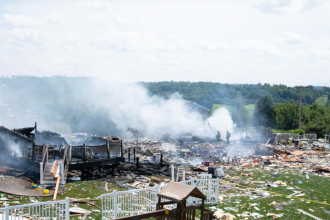Hostages kidnapped by Hamas were released on Friday and Saturday as part of the first phase of an exchange arrangement mediated by Qatar and Egypt with assistance from the United States. As part of the agreement, Palestinian inmates imprisoned by Israel were released on Friday, and more were anticipated to be released on Saturday.
The swap, which is likely to be facilitated by a four-day truce in combat between Israel and Hamas, will see the release of 50 hostages abducted by Hamas and 150 imprisoned Palestinians.
The majority are women and children. There were no Americans among those released in the first two waves.
During the delay, Egypt is allowing extra humanitarian aid for the Gaza Strip to reach the border.
The following is what we know about the captives.
What number of hostages were released on Friday and Saturday, and who were they?
On Friday, thirteen Israeli women and children were turned up to the International Committee of the Red Cross in Gaza. They subsequently made their way to Israel via Egypt. According to Israeli officials, another 13 Israelis were freed on Saturday.
According to Thailand’s prime minister, Hamas freed 12 Thai nationals on Friday. On Saturday, Israeli officials announced the release of four more Thai abductees.
Israel released up to 39 Palestinian inmates on Friday.
Was the release of captives on Saturday delayed?
Officials participating in the negotiations for the releases acknowledged a delay on Saturday, introducing ambiguity into the underlying deal.
According to Hamas, the delay was caused by the volume of humanitarian aid entering the Gaza Strip. Hundreds of vehicles providing supplies had arrived, according to Israeli officials.
How many captives are there in total?
On October 7, Hamas abducted over 240 individuals from rural towns, military bases, and a music festival in southern Israel while also killing approximately 1,200 people. According to Israeli authorities, there are 33 kid captives.
Hamas had already released four prisoners. Judith Raanan, 59, and Natalie Raanan, 17, were both dual nationals of the United States and Israel. On October 20, they were released for “humanitarian reasons.” Two Israeli ladies, Nurit Cooper, 79, and Yocheved Lifshitz, 85, were released three days later.
The bodies of two captives were retrieved earlier this month, according to Israel’s military. Yehudit Weiss, 65, was one among them, as was Noa Marciano, a 19-year-old female soldier.
On October 30, Israeli soldiers rescued Ori Megidish, a 19-year-old female soldier.
What are the identities of the Hamas hostages?
Many of them are Israeli citizens. According to the Israeli government, more than 50% of many have dual citizenship with other nations such as Argentina, the United Kingdom, Chile, France, Germany, Portugal, Spain, Thailand, and the United States.
At least nine Americans are presumed to be captives in Gaza.
Preschoolers, persons with disabilities, the elderly, Thai agricultural laborers, and Israeli troops are among the hostages.
One of the American captives is a three-year-old child whose parents were murdered by Hamas in their house on the southern Israeli kibbutz of Kfar Aza. This kibbutz is located near the Gaza border.
“I will be overjoyed for those families who can be reunited with their loved ones,” American Jonathan Dekel-Chen, 60, said late Thursday in a brief interview. Sagui, his 35-year-old son, is not anticipated to be released anytime soon.
His son, an entrepreneur whose “moonlighting gig is repurposing old buses for new uses,” he described as “the son anyone would love to have.” You can’t meet him without smiling. He’s a perpetual optimist. He works as a builder. He’s a maker. He’s been like that his whole life.”
Who are the Palestinians that Hamas wants to see released?
The Israeli justice ministry has issued a list of 300 Palestinians incarcerated in Israeli prisons who are eligible for the initial exchange or subsequent exchanges if the original four-day truce period is prolonged.
There are 123 juveniles under the age of 18 on the list. Five of the names on the list are 14 years old or younger. The Palestinians on the list were imprisoned for crimes ranging from throwing firebombs to arson. Israel has refused to release any convicts guilty of murder.
Samed Khaled Abu Khalaf, 17, of Palestine, is named in a justice ministry document as having been arrested in April for “damage to the security of the area.”
His father, Khaled, 51, stated in a brief WhatsApp message Friday that Israel had imprisoned his son for a period of time.
According to the Palestinian prisoners’ rights organization Addameer, Israel detains over 200 males, most of whom are teens, as well as many teenage girls. International and Palestinian human rights organizations have long claimed that Israel mistreats its minor captives, who are prosecuted in military courts and held indefinitely. According to Israel, they are being held for alleged terrorist-related acts.
Khaled Mahmoud Abu Khalaf stated early Friday that he expected to hear from the International Committee of the Red Cross about his son’s release. The organization is assisting in the release of both parties.
“Today, God willing,” he promised.
What are the circumstances in Gaza for hostages?
Little public information is available concerning the particular conditions under which hostages are held.
As additional captives are freed, a more complete picture will emerge.
Both Israel and Hamas claim that hostages are housed in tunnels under Gaza. The Israeli military claims to have information that several captives were detained in or near hospitals. Hamas seemed to disagree.
Mirjana Spoljaric, head of the International Committee of the Red Cross, came to Qatar earlier this week to discuss the condition of the detainees with Hamas leader Ismail Haniyeh.
The Red Cross stated after the meeting that it was still insisting on “our teams being allowed to visit the hostages to check on their welfare and deliver medications, and for the hostages to be able to communicate with their families.”
Lifshitz, an 85-year-old lady who was released after being imprisoned for 17 days, claimed she was abused while being seized on the back of a motorcycle by Hamas. She claimed she was then led through a “spider web” of subterranean tunnels where Hamas conceals militants and weapons.
“I went through hell,” Lifshitz told reporters in a Tel Aviv hospital the day following her release.
Lifshitz claimed she was repeatedly punched in the ribs on the day of her kidnapping, making it difficult for her to breathe. She was then driven across fields to a tunnel network. She claimed she was imprisoned in a vast hall and that her captors “treated us gently and fulfilled all of our needs,” including food and medicine.
Lifshitz claimed that she and her kidnappers slept on mattresses on the tunnel floors.
Mia Schem, a 21-year-old French-Israeli lady kidnapped by Hamas after its surprise attack at the music festival, is shown being treated by an unnamed medical professional for an arm injury received during the attack in a Hamas video published in the middle of last month.
That same month, Hamas produced a video with three female detainees criticizing Israeli Prime Minister Benjamin Netanyahu. Both films, according to Israel, were evidence of Hamas’ “cruel propaganda.”














